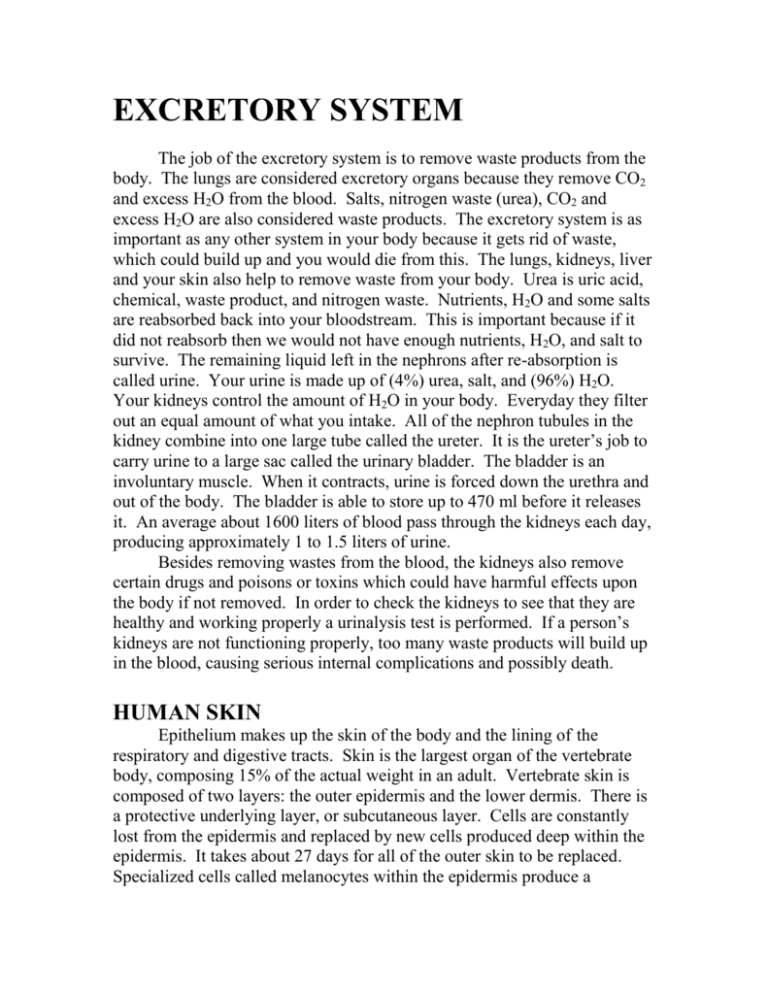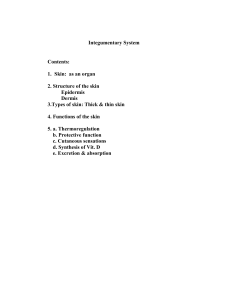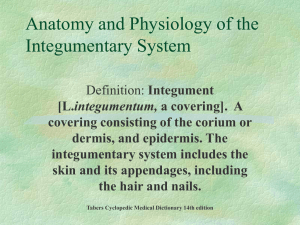THE EXCRETORY SYSTEM
advertisement

EXCRETORY SYSTEM The job of the excretory system is to remove waste products from the body. The lungs are considered excretory organs because they remove CO2 and excess H2O from the blood. Salts, nitrogen waste (urea), CO2 and excess H2O are also considered waste products. The excretory system is as important as any other system in your body because it gets rid of waste, which could build up and you would die from this. The lungs, kidneys, liver and your skin also help to remove waste from your body. Urea is uric acid, chemical, waste product, and nitrogen waste. Nutrients, H2O and some salts are reabsorbed back into your bloodstream. This is important because if it did not reabsorb then we would not have enough nutrients, H2O, and salt to survive. The remaining liquid left in the nephrons after re-absorption is called urine. Your urine is made up of (4%) urea, salt, and (96%) H2O. Your kidneys control the amount of H2O in your body. Everyday they filter out an equal amount of what you intake. All of the nephron tubules in the kidney combine into one large tube called the ureter. It is the ureter’s job to carry urine to a large sac called the urinary bladder. The bladder is an involuntary muscle. When it contracts, urine is forced down the urethra and out of the body. The bladder is able to store up to 470 ml before it releases it. An average about 1600 liters of blood pass through the kidneys each day, producing approximately 1 to 1.5 liters of urine. Besides removing wastes from the blood, the kidneys also remove certain drugs and poisons or toxins which could have harmful effects upon the body if not removed. In order to check the kidneys to see that they are healthy and working properly a urinalysis test is performed. If a person’s kidneys are not functioning properly, too many waste products will build up in the blood, causing serious internal complications and possibly death. HUMAN SKIN Epithelium makes up the skin of the body and the lining of the respiratory and digestive tracts. Skin is the largest organ of the vertebrate body, composing 15% of the actual weight in an adult. Vertebrate skin is composed of two layers: the outer epidermis and the lower dermis. There is a protective underlying layer, or subcutaneous layer. Cells are constantly lost from the epidermis and replaced by new cells produced deep within the epidermis. It takes about 27 days for all of the outer skin to be replaced. Specialized cells called melanocytes within the epidermis produce a brownish pigment called melanin. People of all races have about the same number of melanocytes but differ in the amount of melanin produced, thus giving a vast range of skin tones. The dermis is composed mainly of connective tissue, which gives the skin its strength and elasticity. Among the structures in the dermis are blood vessels, nerves, hair follicles, oil glands and sweat glands. Wrinkling of the skin occurs in the dermis layer. Leather goods are made of animal dermis (skin). KIDNEYS The kidneys are the main organs of the excretory system! You have 2 kidneys and they sit just above the waist on each side near your back in your body. The kidneys filter your blood. Your kidneys are divided into an inner and outer section. The outer section contains millions of tiny filtering units called nephrons. Here liquid from the blood flows through capillary walls into the nephron tubule. Water, salt, urea, nutrients are filtered out of the blood here. Proteins and RBC can not be filtered out here because they are too big. THE LIVER: as an excretory organ The liver filters your blood. It recycles old worn out red blood cells (RBC). It recycles damaged (dead) cells in general. It removes certain drugs and poisons from the blood (like alcohol). The liver breaks down proteins into smaller amino acids. The liver cleans blood by removing and digesting most of the bacteria that enter the blood from large intestines. THE SKIN Often referred to as the largest organ in the human body, the skin is another important excretory organ. The skin covers an area of approximately 1.5 to 2 meters2 in an average person and can be up to 6 millimeters deep. It is composed of two major layers ~ the epidermis or thin outer layer and the dermis or thicker inner layer. THE EPIDERMIS The epidermis is composed of a layer of dead cells on top of a layer of living cells. As living cells divide, older cells are pushed towards the surface and are shed off your skin. That is how your skin is constantly being shed and replaces itself. There are no blood vessels or nerve endings in your skin. That is how you can puncture the epidermis and not bleed or feel pain. The epidermis forms a waterproof barrier between the living cells and the outside environment. THE DERMIS The dermis is a thicker, tougher, more elastic and complex layer than the epidermis. Because the dermis is composed of living cells, it must receive oxygen and nutrients from the capillaries. It also contains millions of nerve endings, making it a useful sense organ. GLANDS Sweat glands help the body to get rid of excess water salt, and wastes such as urea. These substances form a liquid called perspiration or sweat. Not only does this help the body to get rid of wastes but also to control temperature cooling the body. (10 liters of sweat in 24 hours) Oil glands keep the skin soft and prevent hair from becoming brittle. Your hair and nails are formed from specialized dead skin cells. NERVES The skin also acts as a sense organ. Nerve endings in the skin make you sensitive to hot, cold, pain, and pressure. One area of the body containing a large number of nerve endings are the fingertips. SUMMARY OF FUNCTIONS SKIN ~ protects your body from harmful bacteria and other organisms SKIN ~ keeps your body from drying out SKIN ~ protects your body from harmful effects of the sun SKIN ~ controls body temperature SKIN ~ senses the external environment SKIN ~ functions as an excretory organ!









